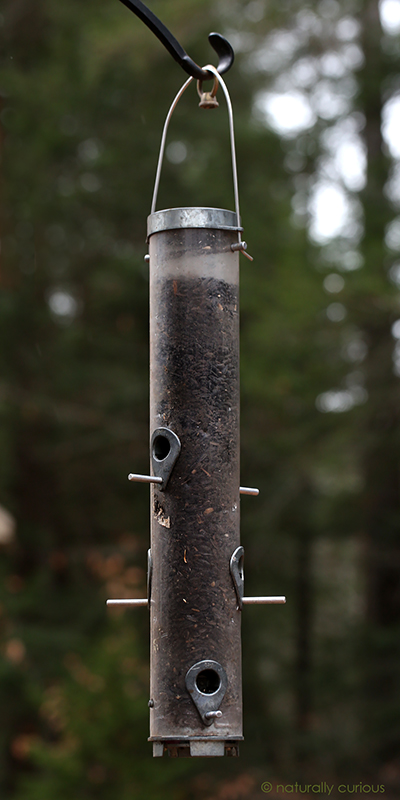Where Are All The Birds?

Even though signs as well as sightings of active bears are plentiful, and black-oiled sunflower seeds are an open invitation for them to visit and potentially become “nuisance” bears, many devoted bird-lovers have already hung out feeders in hopes of luring feathered friends closer to their home. Throughout northern New England so few birds have been attracted to these feeders that they have remained full, some not having been refilled since September. Our usual fall and winter visitors appear to have all but vanished, and concern has been growing amongst those who feed birds.
Those familiar with bird feeding habits know that in the fall, when seeds are abundant, feeder visits by resident birds typically slow down. However, this year, at least anecdotally, appears to be extreme in this regard. Warm weather extending into November certainly has lessened birds’ food requirements. But having sunflower seeds sprout in your feeder before the need to replenish them arrives is unusual, if not alarming.
Dr. Pam Hunt, Senior Biologist in Avian Conservation at New Hampshire Audubon, recently shared some of her personal research with the birding world (UV- Birders). Hunt has conducted a weekly, 10 km-long, bird survey near Concord, NH for the past 13 years. In addressing the current concern over a lack of feeder birds, she extracted the data she had accumulated on 12 common birds (Mourning Dove, Downy Woodpecker, Hairy Woodpecker, Blue Jay, Black-capped Chickadee, Tufted Titmouse, White-breasted Nuthatch, White-throated Sparrow, Dark-eyed Junco, Northern Cardinal, House Finch, American Goldfinch) over the last 13 falls, focusing on the period between Oct 1 and Nov 15. After extensive analysis, Hunt concluded that there has not been a dramatic decline in the number of birds this year, relative to the averages of the past 13 years. One cannot argue with scientific evidence (except for, perhaps, #45), but it does seem mighty quiet on the western (northeastern?) front this year.
Tufted Titmice Singing & Calling
 The two-note “Peter-Peter” song of the Tufted Titmouse has just started to ring out through northern New England woods. Although titmice may pair up any time of year, the singing of the males is still a vital part of establishing territory and courtship. The rate and the volume at which these songs are sung is highest during pre-nesting, nest-building, egg-laying and incubation.
The two-note “Peter-Peter” song of the Tufted Titmouse has just started to ring out through northern New England woods. Although titmice may pair up any time of year, the singing of the males is still a vital part of establishing territory and courtship. The rate and the volume at which these songs are sung is highest during pre-nesting, nest-building, egg-laying and incubation.
While the Tufted Titmouse’s song is familiar, its calls are more numerous and varied. Twelve different Tufted Titmouse calls have been identified. They range from the ‘chick-a-dee’ and ‘seet’ calls made in reponse to predators, to the hissing done by a female titmouse in a cavity, defending her nest.
To hear both songs and calls of the Tufted Titmouse, go to https://www.allaboutbirds.org/guide/Tufted_Titmouse/sounds.
Naturally Curious is supported by donations. If you choose to contribute, you may go to http://www.naturallycuriouswithmaryholland.wordpress.com and click on the yellow “donate” button.
Tufted Titmice Singing

“Peter – Peter – Peter.” “Peter – Peter – Peter.” The song of the tufted titmouse is one of the first bird songs heard in late winter. Unlike its scratchy, nasal call note, the titmouse’s song is a relatively loud, clear, two-note whistle which is repeated rapidly up to 11 times in succession. If you become aware of it, it can even become a bit monotonous. While it is mostly males that do the singing, females sometimes give voice to a softer version of this song.
To hear a tufted titmouse’s song and call notes, go to http://www.langelliott.com/wp-content/mary-holland/tufted_titmouse.mp3. (Sound recording © Lang Elliott – langelliott.com & miracleofnature.org)
Naturally Curious is supported by donations. If you choose to contribute, you may go to http://www.naturallycuriouswithmaryholland.wordpress.com and click on the yellow “donate” button.
 There are roughly 85 species of North American birds that are cavity nesters – birds that excavate nesting holes, use cavities resulting from decay (natural cavities), or use holes created by other species in dead or deteriorating trees. Many of them get a jump start on open-nesting birds, due to added protection from the elements. Barred owls, titmice, chickadees, wood ducks, woodpeckers, bluebirds, mergansers – many have chosen a nest site and are busy excavating, lining a cavity or laying eggs long before many other species have even returned to their breeding grounds.
There are roughly 85 species of North American birds that are cavity nesters – birds that excavate nesting holes, use cavities resulting from decay (natural cavities), or use holes created by other species in dead or deteriorating trees. Many of them get a jump start on open-nesting birds, due to added protection from the elements. Barred owls, titmice, chickadees, wood ducks, woodpeckers, bluebirds, mergansers – many have chosen a nest site and are busy excavating, lining a cavity or laying eggs long before many other species have even returned to their breeding grounds.

















What Other Naturally Curious People Are Saying